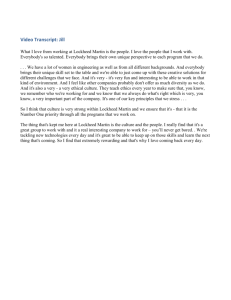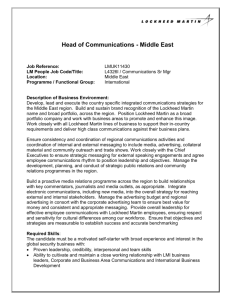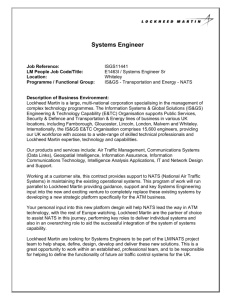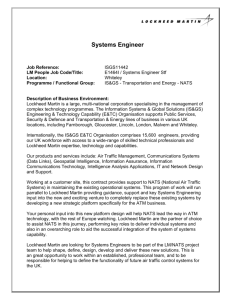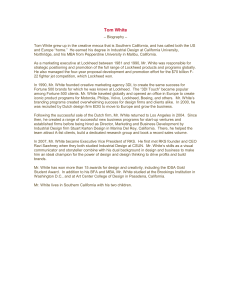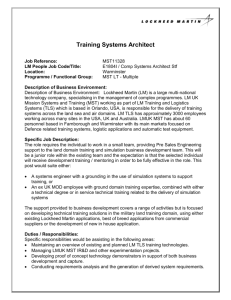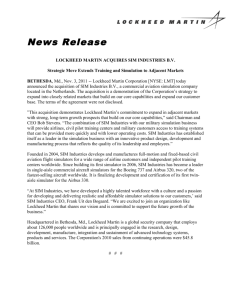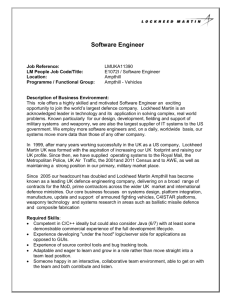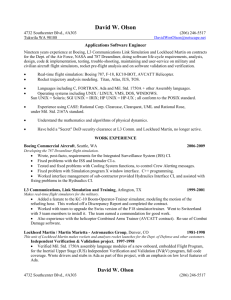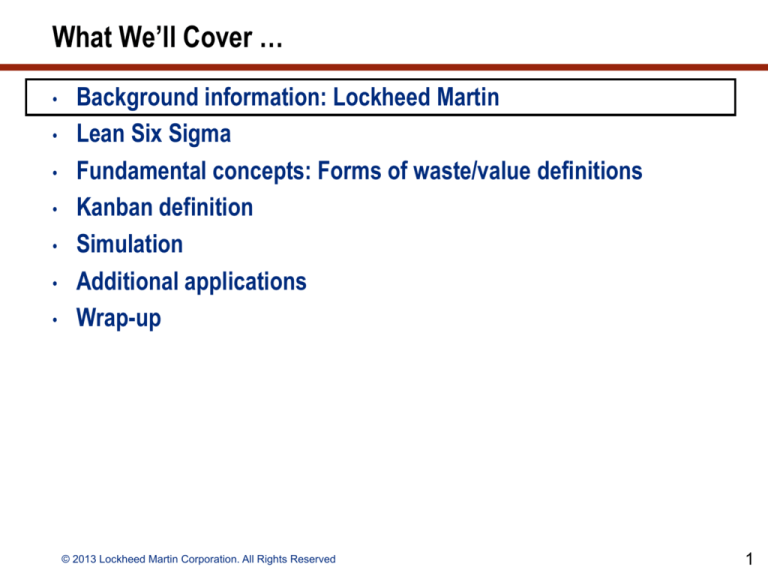
What We’ll Cover …
•
•
•
•
•
•
•
Background information: Lockheed Martin
Lean Six Sigma
Fundamental concepts: Forms of waste/value definitions
Kanban definition
Simulation
Additional applications
Wrap-up
© 2013 Lockheed Martin Corporation. All Rights Reserved
1
Manufacturing Systems
•
Lockheed Martin is a system designer and integrator of complex
systems and services
•
Variation is the beast
•
Lean Six Sigma techniques are used to minimize the effects of
waste and variation in our products and services
•
Data-based decision making
© 2013 Lockheed Martin Corporation. All Rights Reserved
Cp
Cpk
2
What We’ll Cover …
•
•
•
•
•
•
•
Background information: Lockheed Martin
Lean Six Sigma
Fundamental concepts: Forms of waste/value definitions
Kanban definition
Simulation
Additional applications
Wrap-up
© 2013 Lockheed Martin Corporation. All Rights Reserved
3
Lean and Six Sigma: More Succinctly …
Lean
War against
Waste
Six Sigma
War against
Variation
The Customer is the Final Victor!
Used With Permission From Quality Council of Indiana (CSSBB Primer – 2007)
© 2013 Lockheed Martin Corporation. All Rights Reserved
4
Lean Six Sigma Concept
Eliminate Waste First, Then Drive Out Variation
Waste
Reduce Variation
Don’t become proficient at processing waste – seek to eliminate it!
Variation Reduction is Critical To Customer Satisfaction
© 2013 Lockheed Martin Corporation. All Rights Reserved
5
Interaction of Lean and Six Sigma
Rolled Throughput Yield = (Yield A) x (Yield B) x (Yield C) x (Yield D) x (Yield E)
A
B
C
D
E
By definition, Yield is a percentage - a value less than 1. When multiplying multiple
numbers together (all less than 1), the overall product becomes smaller and smaller.
Eliminating unnecessary process steps (B & D in this example),
Rolled Throughput Yield automatically increases!
Used With Permission From Quality Council of Indiana (CSSBB Primer – 2007)
© 2013 Lockheed Martin Corporation. All Rights Reserved
6
Robust Designs and Processes
Robust Designs and processes are insensitive to input variations:
• Manufacturing variations.
• Operating/Environmental factors.
Processes and designs should be particularly robust to the following
types of variations:
• Variations you cannot control.
• Unusually large or highly sensitive.
© 2013 Lockheed Martin Corporation. All Rights Reserved
7
Parts That Do Not Exist …
•
•
•
•
•
•
•
•
•
Are always 100% reliable
Never fail during operational use
Do not require qualification testing
Adds nothing to weight of product or system
Adds nothing to product cost
Cannot be rejected
Do not require inventory or inspection
Have no drawing or specification
Etc.
© 2013 Lockheed Martin Corporation. All Rights Reserved
8
Point of Presentation
Traditional Method:
Receive Parts
From Supplier
Form Parts
Treat Parts
Ready For
Assembly
TRIZ Inventive Principle 10: Perform, before it is needed, the required change of an object
Point of Presentation:
Treat Parts
Ready For
Assembly
© 2013 Lockheed Martin Corporation. All Rights Reserved
Parts and subassemblies
instantly ready for assembly and
system integration. Focus on
Core Competency.
9
What We’ll Cover …
•
•
•
•
•
•
•
Background information: Lockheed Martin
Lean Six Sigma
Fundamental concepts: Forms of waste/value definitions
Kanban definition
Simulation
Additional applications
Wrap-up
© 2013 Lockheed Martin Corporation. All Rights Reserved
10
Value Definitions
•
•
•
Value-added activities
Change in form, fit or function of a product or service
The customer is willing to pay for
Performed right the first time
Non-value-added activities
All other activities, which we call waste. This type of waste can
(and should) be eliminated immediately.
Customer not willing to pay for (Examples: Inspection, rework)
Required non-value-added activities
Activities causing no value to be created but which cannot be
eliminated based on current technology or thinking/process
© 2013 Lockheed Martin Corporation. All Rights Reserved
11
Forms of Waste
•
•
•
•
•
•
•
•
Excessive inventory
Unnecessary transportation
Too many steps to complete a job (over-processing)
Waiting/queue time
Unnecessary motion
Producing defects
Producing too much or too soon (over-production)
Injuries
© 2013 Lockheed Martin Corporation. All Rights Reserved
12
Mistake Proofing
•
•
•
•
•
•
Either makes it impossible to make a mistake or allows the
mistake without allowing the defect
Is not “operator-dependent”
Eliminates the need for monitoring, process control
Is key in the development of robust products and processes
Eliminates variation – turns a variable into a constant
Instrumental in achieving customer satisfaction
© 2013 Lockheed Martin Corporation. All Rights Reserved
13
Robust Processes
Question: Would You Rather Have …
A.
Highly Skilled and
Experienced Subject
Matter Experts
+
Competent
Processes
=
Quality
Product
=
Quality
Product
Or
B.
Competent
Personnel
+
Robust
Processes
Preferred Method!
Goal: Design your processes so that employees don’t have to be “on top of
their game” in order to produce acceptable/high-quality product
© 2013 Lockheed Martin Corporation. All Rights Reserved
14
What We’ll Cover …
•
•
•
•
•
•
•
Background information: Lockheed Martin
Lean Six Sigma
Fundamental concepts: Forms of waste/value definitions
Kanban definition
Simulation
Additional applications
Wrap-up
© 2013 Lockheed Martin Corporation. All Rights Reserved
15
Inventory Versus Flow
Throughput =
Money coming in!
Inventory = Money
stuck inside!
Material should be moved one part at a time (ideally) at a rate
determined by the needs of the customer
Used With Permission From Quality Council of Indiana (CSSBB Primer – 2007)
© 2013 Lockheed Martin Corporation. All Rights Reserved
16
Kanban
•
Kanban is a signal or trigger that identifies the need for
replenishment of material for the next process step
Typical
Kanban
Cards
Kanban cards are used to regulate the flow of production and inventory
Used With Permission From Quality Council of Indiana (CSSBB Primer – 2007)
© 2013 Lockheed Martin Corporation. All Rights Reserved
17
The Heartbeat of Lean
TAKT Time = Heartbeat of Customer Demand
TAKT Time is the calculated time element related to Customer
Demand. More specifically:
TAKT Time =
Available Operating Time
Customer Demand
Minutes
Unit
It is important to make sure that time units are consistent!
© 2013 Lockheed Martin Corporation. All Rights Reserved
18
Concept of Bottleneck
What is the Maximum Output From The Following System Per Hour?
A
B
C
23 Units/Hour
17 Units/Hour
8 Units/Hour
D
19 Units/Hour
E
13 Units/Hour
Answer: 8 Units Per Hour – Process Step C is the Bottleneck
Used With Permission From Quality Council of Indiana (CSSBB Primer – 2007)
© 2013 Lockheed Martin Corporation. All Rights Reserved
19
What We’ll Cover …
•
•
•
•
•
•
•
Background information: Lockheed Martin
Lean Six Sigma
Fundamental concepts: Forms of waste/value definitions
Kanban definition
Simulation
Additional applications
Wrap-up
© 2013 Lockheed Martin Corporation. All Rights Reserved
20
Paper Airplane Simulation
© 2013 Lockheed Martin Corporation. All Rights Reserved
21
Paper Airplane Simulation (cont.)
Characteristic
Run Number
1
Lot Size
5
WIP
32
Total Run Time
7:15
Throughput (Lead) Time
6:32
Deliveries (To Customer)
18
Number of People
6
Space
Productivity
Quality
Run Number
2
Run Number
3
4 Tables
0.42
12
Comments/Observations
© 2013 Lockheed Martin Corporation. All Rights Reserved
22
What We’ll Cover …
•
•
•
•
•
•
•
Background information: Lockheed Martin
Lean Six Sigma
Fundamental concepts: Forms of waste/value definitions
Kanban definition
Simulation
Additional Applications
Wrap-up
© 2013 Lockheed Martin Corporation. All Rights Reserved
23
Hooray! We Improved the Process!
Question: How do you know this to be the case?
I Chart of Cycle Time
Before Improvement
210
After Improvement
200
Cycle Time (Minutes)
190
180
170
160
150
UCL=145.4
140
_
X=130.7
130
120
LCL=116.0
1
7
13
19
25
31
37
Sequence
43
49
55
Show Me The Data!
© 2013 Lockheed Martin Corporation. All Rights Reserved
24
Process Control And Capability
Commute Times
Check For Control First, Then Capability!
© 2013 Lockheed Martin Corporation. All Rights Reserved
25
Comparison of Families of Variation
Compare Means
Compare Variation
Shift in Mean, Change in Variation, or Both!
© 2013 Lockheed Martin Corporation. All Rights Reserved
26
Is There Really a Difference?
Suppose You Have Two Sets of Sample Data:
• Data Set A
• Data Set B
XA
XB
Let’s try a typical approach - use average values:
Has there been an improvement? Yes.
And you want to know if an improvement has
been made. How would you determine this?
Number Line
0
Let’s try a typical approach - use average values:
Has there been an improvement? No, not really.
Number Line
0
Bottom line: You Must Look at the Mean
AND the Variation to determine if an
improvement has been made!
© 2013 Lockheed Martin Corporation. All Rights Reserved
Zone of Mixed Results!
(conflicting results in this area)
27
Conflict Resolution Matrix
Collaborating
“win-win”
Assertive
Price
Lower Price To Customer;
Lower Cost To Supplier;
Higher Profit For Company
Competing
Compromising
After
Before
Lean Six Sigma Lean Six Sigma
Uncooperative
Cooperative
Avoiding
Accommodating
Unassertive
Thomas-Kilmann Conflict Mode Instrument (1975) Model [Used With Permission: Quality Council of Indiana ]
© 2013 Lockheed Martin Corporation. All Rights Reserved
28
What We’ll Cover …
•
•
•
•
•
•
•
Background information: Lockheed Martin
Lean Six Sigma
Fundamental concepts: Forms of waste/value definitions
Kanban definition
Simulation
Additional applications using data mined from ERP/MRP System
Wrap-up
© 2013 Lockheed Martin Corporation. All Rights Reserved
29
7 Key Points to Take Home
•
•
•
•
•
•
•
Keep in mind your core competencies and apply accordingly
Lean – War against waste
Six Sigma – War against variation
Developing robust processes is key to minimizing variation and
improving product quality
Kanban concept: Flow and pull can help improve process
efficiencies (reduce cycle time, WIP and waste)
Data extracts from your ERP/MRP system used in conjunction
with Six Sigma analytical tools can give you very powerful insight
into your business performance
Who defines value? The customer.
© 2013 Lockheed Martin Corporation. All Rights Reserved
30
Additional Resources
•
•
•
•
www.lean.org/whatslean
Lean Enterprise Institute
www.triz-journal.com/whatistriz.htm
TRIZJournal, “What Is TRIZ?” (The TRIZJournal).
Theory of Inventive Problem Solving otherwise known as
TRIZ (pronounced “trees”)
http://asq.org/index.aspx
American Society for Quality (ASQ)
James P. Womack and Daniel T. Jones, Lean Thinking: Banish
Waste and Create Wealth in Your Corporation (Free Press, 2nd
Edition, June 2003).
© 2013 Lockheed Martin Corporation. All Rights Reserved
31
Your Turn!
How to contact me:
Jerry Hamilton
(817) 777-5917
jerry.hamilton@lmco.com
© 2013 Lockheed Martin Corporation. All Rights Reserved
32

